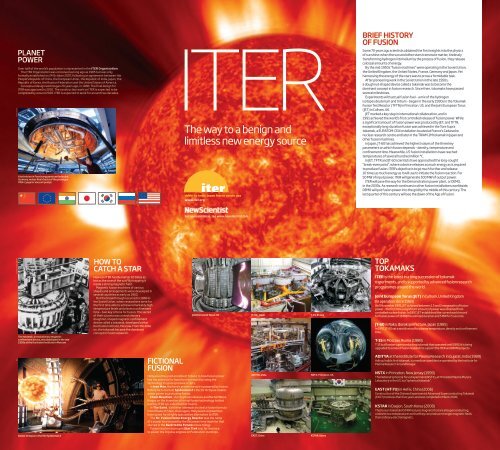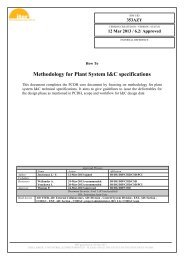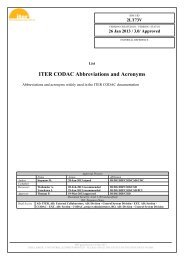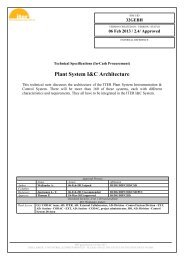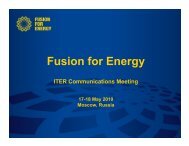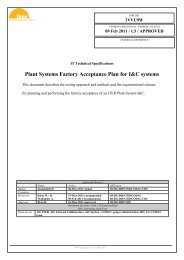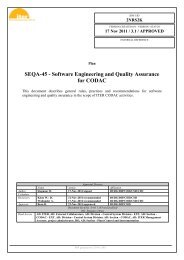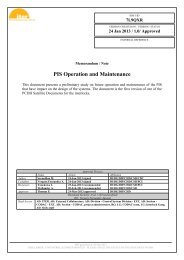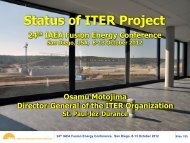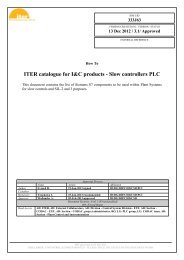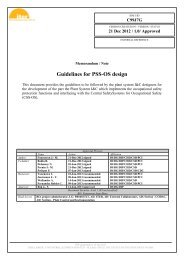Create successful ePaper yourself
Turn your PDF publications into a flip-book with our unique Google optimized e-Paper software.
PETER GINTER<br />
PLANET<br />
POWER<br />
Over half of the world’s population is represented in the <strong>ITER</strong> Organization.<br />
The <strong>ITER</strong> Organization was conceived as long ago as 1985 but was only<br />
formally established on 24 October 2007, following an agreement between the<br />
People’s Republic of China, the European Union, the Republic of India, Japan, the<br />
Republic of Korea, the Russian Federation and the United States of America.<br />
Conceptual design work began 20 years ago, in 1988. The final design for<br />
<strong>ITER</strong> was approved in 2001. The construction work on <strong>ITER</strong> is expected to be<br />
completed by around 2020. <strong>ITER</strong> is expected to work for around two decades.<br />
A technician in Forschungszentrum Karlsruhe,<br />
Germany, makes final checks of the prototype<br />
<strong>ITER</strong> cryogenic vacuum pumps<br />
Iter<br />
The way to a benign and<br />
limitless new energy source<br />
www.iter.org<br />
BRIEF HISTORY<br />
OF FUSION<br />
Some 70 years ago scientists obtained the first insights into the physics<br />
of sunshine: when the sun and other stars transmute matter, tirelessly<br />
transforming hydrogen into helium by the process of fusion, they release<br />
colossal amounts of energy.<br />
By the mid-1950s “fusion machines” were operating in the Soviet Union,<br />
the United Kingdom, the United States, France, Germany and Japan. Yet<br />
harnessing the energy of the stars was to prove a formidable task.<br />
After pioneering work in the Soviet Union in the late 1950s,<br />
a doughnut-shaped device called a tokamak was to become the<br />
dominant concept in fusion research. Since then, tokamaks have passed<br />
several milestones.<br />
Experiments with actual fusion fuel – a mix of the hydrogen<br />
isotopes deuterium and tritium – began in the early 1990s in the Tokamak<br />
Fusion Test Reactor (TFTR) in Princeton, US, and the Joint European Torus<br />
(JET) in Culham, UK.<br />
JET marked a key step in international collaboration, and in<br />
1991 achieved the world’s first controlled release of fusion power. While<br />
a significant amount of fusion power was produced by JET, and TFTR,<br />
exceptionally long-duration fusion was achieved in the Tore Supra<br />
tokamak, a EURATOM-CEA installation located at France’s Cadarache<br />
nuclear research centre and later in the TRIAM-1M tokamak in Japan and<br />
other fusion machines.<br />
In Japan, JT-60 has achieved the highest values of the three key<br />
parameters on which fusion depends – density, temperature and<br />
confinement time. Meanwhile, US fusion installations have reached<br />
temperatures of several hundred million °C.<br />
In JET, TFTR and JT-60 scientists have approached the long-sought<br />
“break-even point”, where a device releases as much energy as is required<br />
to produce fusion. <strong>ITER</strong>’s objective is to go much further and release<br />
10 times as much energy as it will use to initiate the fusion reaction. For<br />
50 MW of input power, <strong>ITER</strong> will generate 500 MW of output power.<br />
<strong>ITER</strong> will pave the way for the Demonstration power plant, or DEMO,<br />
in the 2030s. As research continues in other fusion installations worldwide,<br />
DEMO will put fusion power into the grid by the middle of this century. The<br />
last quarter of this century will see the dawn of the Age of Fusion.<br />
For news and ideas, see www.newscientist.com<br />
REX SCIENCE PHOTO LIBRARY<br />
The tokamak, a revolutionary magnetic<br />
confinement device, was developed in the late<br />
1950s at the Kurchatov Institute in Moscow<br />
Doctor Octopus in the film Spiderman 2<br />
HOW TO<br />
CATCH A STAR<br />
How can <strong>ITER</strong> handle matter 10 times as<br />
hot as the core of the sun By trapping it<br />
inside a strong magnetic field.<br />
Magnetic fusion machines of various<br />
shapes and arrangements were developed in<br />
several countries as early as 1950.<br />
But the breakthrough occurred in 1968 in<br />
the Soviet Union, when researchers were for<br />
the first time able to achieve remarkably high<br />
temperature levels and plasma confinement<br />
time – two key criteria for fusion. The secret<br />
of their success was a revolutionary<br />
doughnut-shaped magnetic confinement<br />
device called a tokamak, developed at the<br />
Kurchatov Institute, Moscow. From this time<br />
on, the tokamak became the dominant<br />
concept in fusion research.<br />
FICTIONAL<br />
FUSION<br />
Joint European Torus, UK<br />
Hollywood has paid an indirect tribute to how fusion power<br />
has the potential to transform our world by using the<br />
technology to spice up movie scripts.<br />
In Iron Man, the hero’s protective suit is powered by fusion.<br />
Before he turns bad, Spiderman 2’s Doctor Octopus creates<br />
a new power source using fusion.<br />
Chain Reaction, starring Keanu Reeves and Rachel Weisz,<br />
hinges on the invention of a rival fusion technology to that<br />
used by <strong>ITER</strong> (so-called bubble fusion).<br />
In The Saint, Val Kilmer attempts to steal a fusion formula<br />
from Elisabeth Shue. Once again, Hollywood scriptwriters<br />
have opted for a highly speculative alternative to <strong>ITER</strong>.<br />
The Mr. Fusion Home Energy Reactor was the name<br />
of a power source used by the DeLorean time machine that<br />
starred in the Back to the Future movie trilogy.<br />
Fusion reactors turn up in Star Trek too, for instance<br />
to power the impulse engines on Federation starships.<br />
JT-60, Japan<br />
ADITYA, India<br />
EAST, China<br />
T-15, Russia<br />
NSTX, Princeton, US<br />
KSTAR, Korea<br />
TOP<br />
TOKAMAKS<br />
<strong>ITER</strong> is the latest in a long succession of tokamak<br />
experiments, and is supported by advanced fusion research<br />
programmes around the world.<br />
Joint European Torus (JET) in Culham, United Kingdom<br />
(in operation since 1983)<br />
On 9 November 1991, JET achieved between 1.5 and 2 megawatts of fusion<br />
power – the first time a significant amount of power was obtained from<br />
controlled nuclear fusion. In 1997, JET established the current world record<br />
for fusion power of 16 MW for a limited duration and 5 MW for 5 seconds.<br />
JT-60 in Naka, Ibaraki prefecture, Japan (1985)<br />
In 1997, JT-60 set a world record for plasma temperature, density and confinement<br />
time.<br />
T-15 in Moscow, Russia (1988)<br />
T-15 is a Russian superconducting tokamak that operated until 1995. It is being<br />
upgraded to conduct fusion research to support the <strong>ITER</strong> and DEMO projects.<br />
ADITYA at the Institute for Plasma Research in Gujarat, India (1989)<br />
Aditya, India’s first tokamak, is a medium-sized device operated by the Institute for<br />
Plasma Research in Gandhinagar.<br />
NSTX in Princeton, <strong>New</strong> Jersey (1999)<br />
The National Spherical Torus Experiment (NSTX), at Princeton Plasma Physics<br />
Laboratory in the US, is a “spherical tokamak”.<br />
EAST (HT-7U) in Hefei, China (2006)<br />
Construction of the Chinese Experimental Advanced Superconducting Tokamak<br />
(EAST) took less than five years and was completed in March 2006.<br />
KSTAR in Daejon, South Korea (2008)<br />
The Korean tokamak KSTAR features magnets that are all superconducting,<br />
cooled to low temperatures so that they can produce stronger magnetic fields<br />
than ordinary electromagnets.


